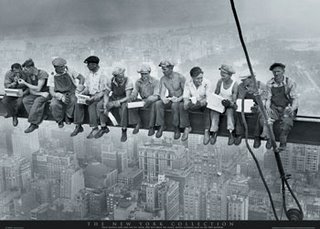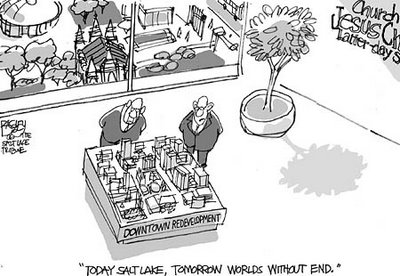If that's a word... but anyway.
I was thinking about that post yesterday.. the one about Walmart, and it got me thinking about how our society as a whole has succumbed to existence at the lowest common denominator.
Think about this:

In the early- to middle-20th century, our nation underwent a mini industrial revolution. It was War time, with the Two Great Wars. Prior to that time, all machined items, whether they were parts for farm equipment, logging equipment, whatever, were pretty much produced as one-off, one of a kind items. Henry Ford then moved us to the next step, by putting automobile manufacturing onto an assembly line system, where parts were mass-produced and installed in the same place and same way on every vehicle.
Many of our forbears were factory workers.

Props to
RiveterGirl, whose Colorado rock band is named after Rosie The Riveter, an icon of that time.
Then it was war-time, and the great majority of those workers went to war. To fight mostly hand-to-hand combat. Now, I'm not taking anything away from today's servicemen, but holy crap, can you imagine the courage THAT took??!! I digress.
Anyway, all those factories were turned over to production of war-time needs. Munitions, military vehicles, airplanes, etc. Daylight Savings was implimented then (and should be abolished now). But I digress again. Sorry.
Then, when they all came back, they had the GI bill that allowed them to buy a home.

At the same time, the nation's homebuilders had taken this production line format over to building homes in a hurry, for $7000, because they needed to. California was a great example of this, where there were great massive communities cranked up almost overnight, because the homes were all the same, and the workers knew what they were doing. Right angles, straight lines. Boxes. This has spurred the trades' specialization to this day - you have drywall guys, stucco guys, brick masons, HVAC, roofing, etc.
The nation quickly filled up with homes that were all the same. The only individuality between them was whether you wanted it garage-left, or garage-right. There was a standard set of acceptable designs: Bungalow - LR/Kitchen one side, MBR/2nd BR other side, bathroom in the middle, Split Level - Main Kitchen/LR, bedrooms up, more living down, and Two-Story, with its cousin, the Split-Entry - Kitchen/LR main, Bedrooms up, unfinished down. Take a look around your neighborhood today, even if you live in a new community, you'll see that this hasn't changed much over time.
Up until this time, Architects reigned supreme, because most homes were designed by them on a one-off basis, or at least a very few of the same designs built in disparate areas. There were MANY residential architects then.

Many of them famous to this day. The last great age of "the residential architect for the everyday" ended in the middle 50's and early 60's, when homebuilders went with three, four or five designs, and built the great preponderance of the nation's homes we still live in today.
This month's Dwell Magazine has a short but interesting article about Frank Lloyd Wright, of whom, if you know me or have read here for a while, I am a fan. He built about 90 homes in the 50's, his most productive decade for private residences. MOST of those homes are still owned and lived in by the original owners. What does that say about those people?
1. They were young, and went against the early homogenization of the nation's residential trends.
2. They were more well-off than the regular folk.

While number 1 is true, as witnessed by the fact that many are still in the homes today, 65 years later, number two isn't necessarily so. There was a story about one of those owners who had to wait 7 years to be able to save up the money to be able to engage Wright on a home design for them.
What those people were, however, was willing to go against the homogeneous societal trends and insist on some individuality in their home. Sure, we'd all love to live at Fallingwater, an iconic

American home - who wouldn't? I'd give my left nut to live in ANY wright house. But you don't have to have one of those in mind in order to engage an architect either.
I don't know for sure, but I am betting that there are fewer residential acrchitects per capita today than there were 75 years ago. By the same token I am betting that there are fewer homes designed by architects built today than then. And I'm not talking about these huge Garage Mahals, or starter-castles, either. You don't have to build a huge behemoth in order to instill some individuality in your abode. I am willing to bet that there are architects out there who would jump all over the chance to design a home that costs $150,000 - $200,000 these days.
You will say
yes, but there are economic factors at play here - things are different now than they were then. Companies make it easier today to work with them, and get your home cranked out in three months, looking just like everyone else's. But that's really the entire point of this post isn't it?? We accept what is easy as the only way to go - we've gotten lazy in what we expect from a service provider, be it our DSL service, our home builder, our grocer.
You have to buy a lot now, get your design approved, etc. It's harder to do it yourself. It's more expensive, you say.
But I will say to you that
financing is out there, people just don't know it - it can be about as economical as working with one of the major home-builders - and you will get 10 times the home, I promise. You'll just have to be a little more pro-active in your thinking, and what you will agree to accept. You can get it done - it's a little more work, but you get back exponentially what you put in.
So, why do I ramble on about this stuff? Especially in connection with the Walmart post I wrote yesterday? It's because we as a society are so willing to accept what is put in front of us as the best thing for us. This is true whether it be where we live, where we shop, what we eat, how we travel. The individual is being stamped out of existence as we are all forced to do the same things, live in the same homes, shop at the same places, buying the same things as everyone else.
Where did our individuality go? Are we not creative anymore? Did we fall asleep somewhere along the way, and just decide that we should all live in the same thing, buy at the same store, eat the same things?
I don't think that's healthy for a society, and it shows in caricature, when we allow huge builders to build massive communities in our cities, or allow massive retailers to tell us what we will buy.
Resistence is futile - you will be assimilated. Now go back to your stucco 2500 square foot split level homes, nothing more to see here.
I'm just sayin'.
 We went to the Blue Man Group concert last night - fun times had by all... crappy telephone picture captures all, and at the same time, nothing.
We went to the Blue Man Group concert last night - fun times had by all... crappy telephone picture captures all, and at the same time, nothing.















































